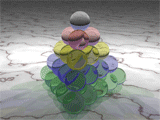Tetrahedral number

A tetrahedral number is a number that is based on the formula
can be calculated from a natural number . The first tetrahedral numbers are
For some authors, zero is not a tetrahedral number, so the sequence of numbers only begins with one.
The name tetrahedral number is derived from a geometric property. If you put stones into a tetrahedron by laying triangles on top of each other, the side lengths of which increase by one from top to bottom, then the number of stones corresponds to a tetrahedron number. This is the number of these triangles and thus also the number of stones that form an edge of the tetrahedron. Because of this relationship with a geometric figure , the tetrahedral numbers are among the figured numbers , which also include the triangular and square numbers . In addition to triangles, other polygons can also be used as the outline of pyramids. These bodies lead to further pyramid numbers .
Their geometric representation is a tetrahedral cluster in the closest packing of spheres , as can be seen as a decorative layering of oranges (or other spherical fruits) at the fruit dealer.
In particular, 20 (the fourth tetrahedral number, represented by a tetrahedral cluster of base length 4) corresponds to the three-dimensional extension of the Tetraktys (the fourth triangular number 10, sacred for the Pythagoreans ) and contains this as base and side surfaces.
A surprising property of these clusters is remarkable: In contrast to the regular tetrahedron, with tetrahedron clusters up to a base length of 4 it is possible to fill the space in the cubic closest packing of spheres without any gaps.
The formula for the -th tetrahedral number can also be written using a binomial coefficient :
Relationships to other figured numbers
The -th tetrahedral number is the sum of the first triangular numbers .
Since the -th triangular number is itself the sum of the first natural numbers, the tetrahedral numbers are their spatial generalizations.
Only five numbers are both triangle number and tetrahedron number: 1, 10, 120, 1540, 7140. (Sequence A027568 in OEIS )
Three numbers are both a square and a tetrahedron: 1, 4, 19600.
The tetrahedral numbers can be summed up again and the sum of the first tetrahedral numbers is the -th pentatope number .
Sum of the reciprocal values
The sum of the reciprocal values of all tetrahedral numbers is .
Generating function
The function
contains in its series expansion (right side of the equation) the -th tetrahedral number as a coefficient to . It is therefore called the generating function of the tetrahedral numbers.








